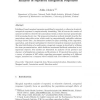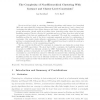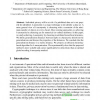1285 search results - page 9 / 257 » On the Complexity of Ordinal Clustering |
ICDM
2005
IEEE
14 years 1 months ago
2005
IEEE
Bayesian Network (BN) is a powerful network model, which represents a set of variables in the domain and provides the probabilistic relationships among them. But BN can handle dis...
CSDA
2006
13 years 7 months ago
2006
Likelihood-based marginal regression modelling for repeated, or otherwise clustered, categorical responses is computationally demanding. This is because the number of measures nee...
CVPR
2009
IEEE
15 years 1 months ago
2009
IEEE
We describe a novel and robust feature descriptor called ordinal spatial intensity distribution (OSID) which is invariant to any monotonically increasing brightness changes. Many t...
DATAMINE
2007
13 years 7 months ago
2007
Recent work has looked at extending clustering algorithms with instance level must-link (ML) and cannot-link (CL) background information. Our work introduces δ and ǫ cluster lev...
DAWAK
2006
Springer
13 years 11 months ago
2006
Springer
Abstract. Individual privacy will be at risk if a published data set is not properly de-identified. k-anonymity is a major technique to de-identify a data set. A more general view ...



